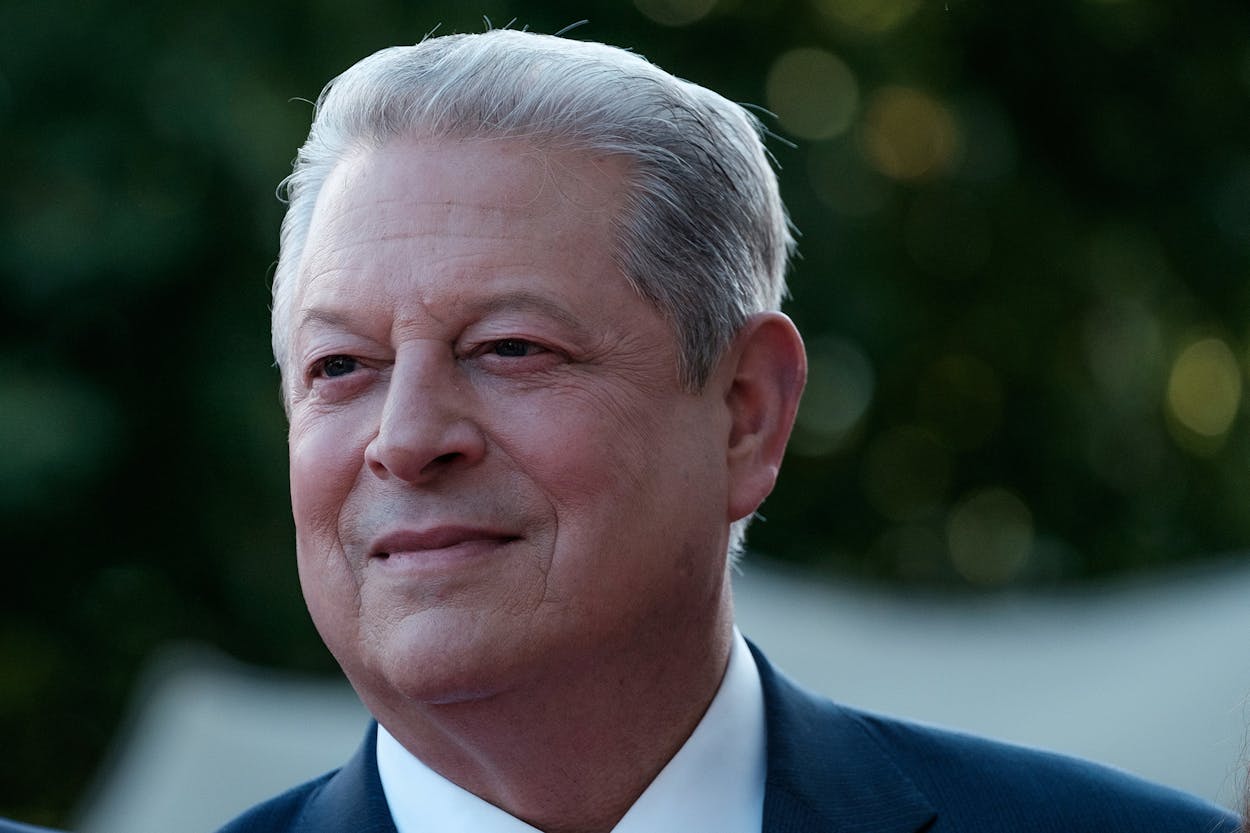Dale Ross, the mayor of Georgetown, won re-election in May by 45 points. That means he can say pretty much anything he wants—and when introducing former vice president Al Gore at the Texas Renewable Energy Industries Alliance (TREIA) conference on Monday, the city’s Republican leader put that to the test. “It’s no secret that he’s a Democrat and I’m a Republican,” Ross said from the ballroom of the Georgetown Sheraton. The hotel is one of the new projects that came about as part of $225 million in development Ross announced as part of his commitment to making Georgetown one of the first—and largest—cities to be powered by entirely by renewable energy sources. “But these are not political decisions. Al Gore has done more to make the world a better place in one day than most of his critics have done in their entire lives.”
Ross’s comments set a tone for Gore’s presentation—an updated, curated-for-Texas version of the slideshow setup he made famous in An Inconvenient Truth and its sequel—that balanced discussing the economic realities that lead to Ross’s push on renewables, the risks of climate change that have long motivated Gore, and some sassy political sniping in the direction of Energy Secretary Rick Perry.
Addressing TREIA’s GridNEXT conference, Gore opened the presentation by offering an overview of the challenges of climate change—updated for the fall of 2017 with a great deal of imagery and commentary taken from the hurricane season, with a special focus on Harvey and Houston. He discussed the feedback loop that leads to a storm like Harvey being so devastating—how a hurricane usually pulls up cold deep water from the ocean, which short-circuits the storm, but because the Gulf waters were seven degrees warmer than usual as far down as 200 meters deep, that didn’t happen in this case, leading to a storm that lasted so much longer than anyone had come to expect. He quoted state climatologist John Nielsen-Gammon, who refuted the argument that the issue was one of zoning and planning, rather than extreme weather: “Even the best urban preparations in the world would not have been designed for an event as extreme as Harvey.”
The presentation was obviously geared to Texas, but it wasn’t about Texas. Rather, Gore worked to connect the extreme weather of Harvey with extreme weather around the world: flooding in Miami, San Juan, and Havana, as well as China, Bangladesh, and Nigeria. Heat in Texas (six cities in Texas set all-time-high temperature records in 2017) with heat in the Middle East, describing the heat index in Bandar Mahshahr, Iran, last year at 165 with an incredulous laugh—and connecting that with a likely massive migration crisis, as parts of the world become increasingly uninhabitable, and what that means for global politics in 2017. It wasn’t groundbreaking for Gore to address, but it was impressive in how up-to-date it was.
The former vice president also got into politics in a more real way as he pivoted the topic to renewable energy and the recent grid study from Rick Perry’s Department of Energy. He addressed his previous familiarity with the former governor of Texas, calling Perry his friend. “I say he’s a friend of mine, but he probably won’t own up to that now,” Gore said, explaining that Perry served as the chairman of Gore’s campaign in the Democratic primary in Texas during the campaign. Then he took aim at the DOE’s conclusion that the way to ensure a reliable energy grid involved paying heavy subsidies to ensure that coal plants were operating even as demand for the energy they provide was being supplanted by cheaper and more efficient renewable sources. “It really is an excellent study,” Gore said, “Just ignore what [Perry] says and look at the actual text of the study.”
Gore discussed the substance of the issue: that grid parity means that the cost of unsubsidized fossil fuels are roughly equal to the cost of renewables now, and that the trend was moving sharply in a direction that made renewables the future. He compared the current trends in renewable energy to that of cellphones in the year 2000, when a study commissioned by AT&T twenty years earlier had projected would see a consumer market of around 900,000 customers per year. (Certainly, AT&T did sell 900,000 cell phones in 2000—by January 3, 2000, in fact.) As technology gets adopted more widely, Gore explained, costs come down, quality improves, and developing countries who lacked the infrastructure of the previous iteration can skip ahead to what’s next, spiking global adoption. In the case of cellphones, that meant countries without landlines going mobile first; in the case of energy, it means putting solar panels on the roof of grass huts. In either case, though, the idea that investing in old technology as opposed to the tech of the future is one that Gore takes issue with. “It’s ridiculous to force U.S. taxpayers to subsidize non-competitive dirty energy sources of the past,” he said.
Gore’s presentation was a mix of cultural optimism, environmental pessimism, and preaching to a crowd that was there to celebrate the progressive energy policy of Georgetown. While it’s no longer the largest city in the U.S. to be powered entirely by renewable energy—Las Vegas took that title in December, and cities including San Diego and Pittsburgh will be clinching it in the near future—the fact that it was the first to claim the title, with a Republican mayor and a a host of business reasons to do so, validates Gore’s ultimately optimistic view that maybe we aren’t doomed after all.
- More About:
- Energy








